Overview
- Brief Narrative
- Book titled, "Union Hymnal for Jewish Worship" with music and words for services; English, Hebrew; 1914
- Title
- Union Hymnal for Jewish Worship
- Date
-
publication:
1914
- Credit Line
- United States Holocaust Memorial Museum Collection, Gift of the Estate of Hanni Vogelweid
Physical Details
- Classification
-
Books and Published Materials
- Category
-
Books and pamphlets
- Object Type
-
Judaism--Prayer books (lcsh)
- Materials
- overall : paper, ink
Rights & Restrictions
- Conditions on Access
- No restrictions on access
- Conditions on Use
- No restrictions on use
Keywords & Subjects
- Personal Name
- Vogelweid, Hanni.
Administrative Notes
- Legal Status
- Permanent Collection
- Provenance
- The book was donated to the United States Holocaust Memorial Museum in 2007 by Lloyd Vogelweid, the widower of Hanni Vogelweid, on behalf of the Estate of Hanni Vogelweid.
- Record last modified:
- 2024-07-03 10:02:51
- This page:
- https://collections.ushmm.org/search/catalog/irn518990
Download & Licensing
In-Person Research
- By Appointment
- Request 21 Days in Advance of Visit
- Plan a Research Visit
- Request to See This Object
Contact Us
Also in Hanni Sondheimer Vogelweid family collection
The collection consists of artifacts, documents, and publications relating to the experiences of Hanni Sondheimer, her parents, Moritz and Setty, and her brother, Karl, as they emigrated from Berlin, Germany, to Kaunas, Lithuania, and then to Shanghai, China, before and during the Second World War. Some of these materials may be combined into a single collection in the future.
Date: 1930-1947
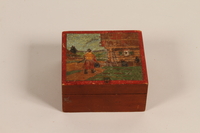
Wooden box with a painted Lithuanian folk scene with man given to a German Jewish refugee
Object
Decorative box kept by 17 year old Hanni Sondheimer as a souvenir of Lithuania when she and her family fled that country in February 1941. Hanni, her parents, Moritz and Setty, and her 14 year old brother, Karl, fled Kaunas due to the Soviet occupation in 1940. They planned to emigrate to the United States, but visa restrictions made them take a difficult route through Russia to Japan. Classified as stateless refugees when they reached Japan in March 1941, they were deported to Shanghai where they survived the war in the Hongkew ghetto. Hanni married a US soldier and emigrated to the United States in 1946. Her family emigrated the next year.
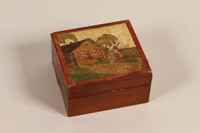
Wooden box painted with a woman in Lithuanian folk dress given to a German Jewish refugee
Object
Decorative box kept by 17 year old Hanni Sondheimer as a souvenir of Lithuania when she and her family fled that country in February 1941. Hanni, her parents, Moritz and Setty, and her 14 year old brother, Karl, fled Kaunas due to the Soviet occupation in 1940. They planned to emigrate to the United States, but visa restrictions made them take a difficult route through Russia to Japan. Classified as stateless refugees when they reached Japan in March 1941, they were deported to Shanghai where they survived the war in the Hongkew ghetto. Hanni married a US soldier and emigrated to the United States in 1946. Her family emigrated the next year.
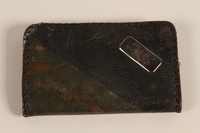
Monogrammed black and tan laced leather wallet used by a German Jewish refugee
Object
Leather billfold received by 17 year old Hanni Sondheimer when she and her family fled Kaunas, Lithuania, in February 1941. It has a scene of Kaunas on the front and was given to her by a friend shortly before her departure. Hanni, her parents, Moritz and Setty, and her 14 year old brother, Karl, fled Kaunas due to the Soviet occupation in 1940. They planned to emigrate to the United States, but visa restrictions made them take a difficult route through Russia to Japan. Classified as stateless refugees when they reached Japan in March 1941, they were deported to Shanghai where they survived the war in the Hongkew ghetto. Hanni married a US soldier and emigrated to the United States in 1946. Her family emigrated the next year.
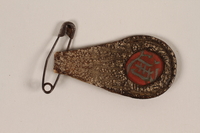
Red enamel permit tag in leather holder issued to a German Jewish refugee
Object
Metal and leather identification tag issued to Moritz Sondheimer when he lived in the Hongkew ghetto in Shanghai, China, from 1941-1945. The tag permitted the bearer to leave the ghetto for work and was color coded to denote the term of valid use. The pass would also include an identification photograph. Moritz, his wife, Setty, and their children, 17 year old Hanni and 14 year old Karl fled Kaunas, Lithuania, in February 1941 following the Soviet occupation in 1940. They planned to emigrate to the United States, but visa restrictions made them take a difficult route through Russia to Japan. Classified as stateless refugees when they reached Japan in March 1941, they were deported to Shanghai where they survived the war in the Hongkew ghetto. Hanni married a US soldier and emigrated to the United States in 1946. Her family emigrated the next year.
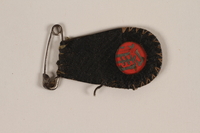
Red enamel permit tag in leather holder issued to a German Jewish refugee
Object
Metal and leather identification tag issued to 17 year old Hanni Sondheimer when she lived in the Hongkew ghetto in Shanghai, China, from 1941-1945. The tag permitted the bearer to leave the ghetto for work and was color coded to denote the term of valid use. The pass would also include an identification photograph. Hanni, her parents, Moritz and Setty, and her 14 year old brother, Karl, fled Kaunas, Lithuania, in February 1941 following the Soviet occupation in 1940. They planned to emigrate to the United States, but visa restrictions made them take a difficult route through Russia to Japan. Classified as stateless refugees when they reached Japan in March 1941, they were deported to Shanghai where they survived the war in the Hongkew ghetto. Hanni married a US soldier and emigrated to the United States in 1946. Her family emigrated the next year.
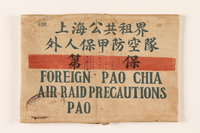
Pao Chia red striped armband worn by a German Jewish refugee
Object
Armband issued to Moritz Sondheimer by the Japanese occupation authorities of the Hongkew ghetto in Shanghai where he lived from 1941-1945. Moritz was required to serve in Pao Chia, a civil and ghetto defense force composed of foreign and Chinese males, aged 20 to 45. Moritz, his wife, Setty, and their children, 17 year old Hanni and 14 year old Karl fled Kaunas, Lithuania, in February 1941 following the Soviet occupation in 1940. They planned to emigrate to the United States, but visa restrictions made them take a difficult route through Russia to Japan. Classified as stateless refugees when they reached Japan in March 1941, they were deported to Shanghai, China, where they survived the war in the Hongkew ghetto. Hanni married a US soldier and emigrated to the United States in 1946. Her family emigrated the next year.
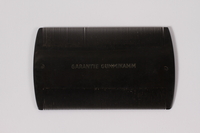
Stamped black plastic dust comb owned by a German Jewish refugee
Object
Lice comb kept by 17 year old Hanni Sondheimer when she and her family fled in February 1941. The comb was made at the plastics factory owned by her father in Kaunas. Hanni, her parents, Moritz and Setty, and her 14 year old brother, Karl, fled Kaunas, Lithuania, due to the Soviet occupation in 1940. They planned to emigrate to the United States, but visa restrictions made them take a difficult route through Russia to Japan. Classified as stateless refugees when they reached Japan in March 1941, they were deported to Shanghai where they survived the war in the Hongkew ghetto. Hanni married a US soldier and emigrated to the United States in 1946. Her family emigrated the next year.
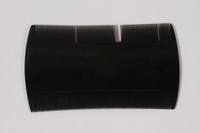
Black plastic dust comb owned by a German Jewish refugee
Object
Lice comb kept by 17 year old Hanni Sondheimer when she and her family fled in February 1941. The comb was made at the plastics factory owned by her father in Kaunas. Hanni, her parents, Moritz and Setty, and her 14 year old brother, Karl, fled Kaunas, Lithuania, due to the Soviet occupation in 1940. They planned to emigrate to the United States, but visa restrictions made them take a difficult route through Russia to Japan. Classified as stateless refugees when they reached Japan in March 1941, they were deported to Shanghai where they survived the war in the Hongkew ghetto. Hanni married a US soldier and emigrated to the United States in 1946. Her family emigrated the next year.
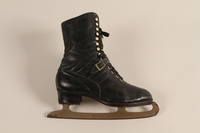
Pair of black leather lace-up ice skates owned by a German Jewish refugee
Object
Pair of ice skates kept by 17 year old Hanni Sondheimer when she and her family fled Lithuania in February 1941. "I couldn't bring much, and I loved ice skating and I could take my ice skates because I thought in America you can ice skate." Hanni, her parents, Moritz and Setty, and her 14 year old brother, Karl, fled Kaunas due to the Soviet occupation in 1940. They planned to emigrate to the United States, but visa restrictions made them take a difficult route through Russia to Japan. Classified as stateless refugees when they reached Japan in March 1941, they were deported to Shanghai where they survived the war in the Hongkew ghetto. Hanni married a US soldier and emigrated to the United States in 1946. Her family emigrated the next year. following the Soviet occupation in 1940. They planned to emigrate to the United States, but quota restrictions made them take a difficult route through Russia to Japan. Classified as stateless refugees when they reached Japan in March 1941, they were deported to Shanghai, China, where they survived the war in the Hongkew ghetto. Hanni married a US soldier and emigrated to the United States in 1946. Her family emigrated the next year.
Estate of Hanni Vogelweid papers
Document
Documents illustrating the experiences of the Sondheimer family who emigrated from Berlin, Germany in 1934 to Kovno, Lithuania and then were forced to flee through Eastern Europe eventually being interned in a ghetto in Shanghai, China, where they remained throughout the Second World War. The collection represents Moritz Sondheimer, his wife Setty and their daughter Hanni; dated 1930's and 1940's; in Lithuanian, German, Chinese and English.
Book
Object
Book titled, "Englisch als erste fremdsprache- Teil 3" with exercises and stories to learn English.
Book
Object
Book titled, "Daily Prayer with English Directions" revised and arranged by A. Hyman; Hebrew, English; 1916
Hanni Vogelweid papers
Document
Contains a marriage certificate and affidavit for Hanni Lore Sondheimer and Alfred Gade, both dated 1946, issued in Shanghai, China; photographs (38) depicting Shanghai, China with images taken on Hanni and Alfred's wedding day as well as street scenes of Shanghail; two full pages from a newspaper entitled "Suchrubruik aus Shanghai," listing advertisements placed by members of the Shanghai Jewish community listing members of their families for whom they are searching, dated circa 1945 or 1946.
Sondheimer family papers
Document
Contains two German passports (Deutsches Reich Reisepass) belonging to donor's parents, Moritz and Setty Sondheimer; donor's brother Karl's identification is included in Moritz's passport, which documents the family's flight from Nazi occupation through Lithuania, Russia, and Japan, and eventually to Shanghai, China where they remained until after the second World War ended. Includes red letter "J" added on date of passport's issue, July 5, 1940, in Kaunas (Kovno), Lithuania, and Moritz's passport includes as his middle name "Israel."



